

Move your mouse over the picture to see the names of the various features. Aristarchus is probably the brightest crater on the Moon and must, therefore, be young (about 450 million years in fact). It is a complex crater, similar to Tycho, but the impact that formed it seems to have cut though three different types of rock so that the ejecta are quite complex. Rays spread up to 150 Km to the south and east, but those that run north and west do not show on the adjoining plateau even though that has to be older. There is something odd about the Aristarchus plateau.
Schröter's Valley is a long sinuous rille, some 165 Km long and mostly between 6 and 10 Km wide and up to 1000 metres deep, which cuts through the Aristarchus plateau. It begins, about 25 Km north of the crater Herodotus, with an elongated crater called "The Head of the Cobra" and winds north before veering to the west. The valley is thought to have been carved by flowing lava emerging from this crater, but it has been calculated that the rate of flow must have been at least 10 million Kg of lava every second and the quantity would have flooded Oceanus Procellarum to a depth of 200 metres.
Herodotus is 36 Km in diameter and 1400 metres deep with a flat, lava-filled floor and is more than 3,000 million years old.
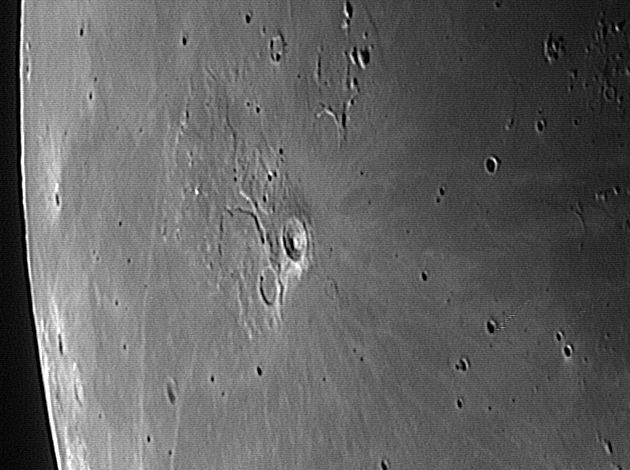 This wide-angle picture shows the area of the Moon centred on Aristarchus. It was taken when the Moon was
24.5 days old so the light is coming from the left (compare with the picture two below). It
was taken when the libration was about as unfavourable as it gets for this part of the Moon
so that the features appear nearer to the limb than they would on average. This picture can be compared with the picture in exaggerated colour below, taken at the same phase and a more neutral libration.
This wide-angle picture shows the area of the Moon centred on Aristarchus. It was taken when the Moon was
24.5 days old so the light is coming from the left (compare with the picture two below). It
was taken when the libration was about as unfavourable as it gets for this part of the Moon
so that the features appear nearer to the limb than they would on average. This picture can be compared with the picture in exaggerated colour below, taken at the same phase and a more neutral libration.
The scale markers are approximately 100 Km north and east and apply around Aristarchus.
The picture was taken in infra-red light with a ToUcam attached to my LX200 on 29th August 2005 at 04:51 UT when the Moon was 24.5 days old.
Libration: latitude -6° 11', longitude 5° 22'
Lunar Phase: 241°
Colongitude: 204.1°
Date and Time: 29th August 2005 04:51 UT
Camera: ToUcam 740K with IR-pass filter
Telescope: LX200 at prime focus (FL 2500 mm)
Capture: K3CCDTools. LOW gamma, 1/25", 53% gain, 427 frames
Processing: Registax. 187 frames stacked. Wavelets 1-2 = 10, Histogram 0-150
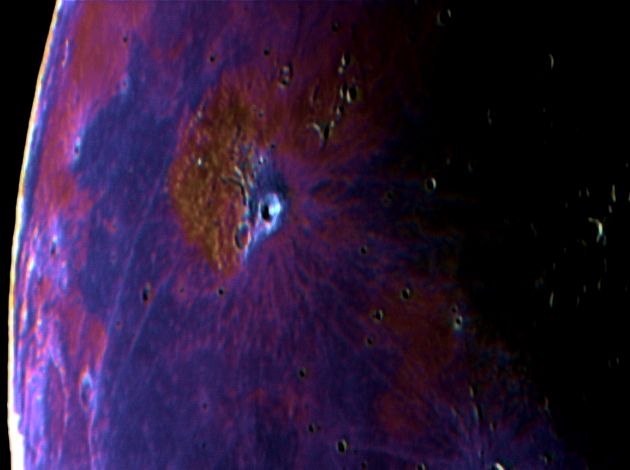 This is the same area, two months later, rendered in exaggerated colour. The thing that really stands out here is the Aristarchus Plateau. This does show on the IR image above but is not nearly so obvious (the plateau can be seen to be a different colour in a colour image even before enhancement). This diamond-shaped plateau is 170 by 200 Km and rises 2 Km above the surrounding plains, and is unique on the visible side of the Moon. There are some interesting differences between the two images, however. If you look carefully at the IR image, you can see that the plateau has straight edges and appears to encompass the crater Aristarchus. In the colour image the edges are less straight and the brown area does not seem to include the crater. I don't doubt that this is caused by the ejecta from the young crater being of a different material to the surface of the plateau; the ejecta rays to the south are nicely shown in pink. The other colours around about are possibly due to different lavas, but more about that elsewhere.
This is the same area, two months later, rendered in exaggerated colour. The thing that really stands out here is the Aristarchus Plateau. This does show on the IR image above but is not nearly so obvious (the plateau can be seen to be a different colour in a colour image even before enhancement). This diamond-shaped plateau is 170 by 200 Km and rises 2 Km above the surrounding plains, and is unique on the visible side of the Moon. There are some interesting differences between the two images, however. If you look carefully at the IR image, you can see that the plateau has straight edges and appears to encompass the crater Aristarchus. In the colour image the edges are less straight and the brown area does not seem to include the crater. I don't doubt that this is caused by the ejecta from the young crater being of a different material to the surface of the plateau; the ejecta rays to the south are nicely shown in pink. The other colours around about are possibly due to different lavas, but more about that elsewhere.
An optical illusion here (to me anyway) is that the Harbinger Mountains tend to look like craters, but remember that the light is coming from the left, so that these are hills not depressions (compare with Tobias Mayer).
The scale is slightly smaller than the picture above and the markers are very approximately 100 Km north and east and apply around Aristarchus.
The picture was taken with a ToUcam attached to my ETX125 on 27th October 2005 at 05:09 UT when the Moon was 24.1 days old.
Libration: latitude -4° 28', longitude 0° 23'
Lunar Phase: 246.7°
Colongitude: 203.7°
Date and Time: 27th October 2005 05:09 UT
Camera: ToUcam 740K with IR-block and Neodymium filters
Telescope: ETX125 at prime focus (FL 1900 mm)
Capture: K3CCDTools. LOW gamma, 1/33", 14% gain, 1029 frames
Processing: Registax. 315 frames stacked. Wavelets 1-2 = 10, Histogram 0-200
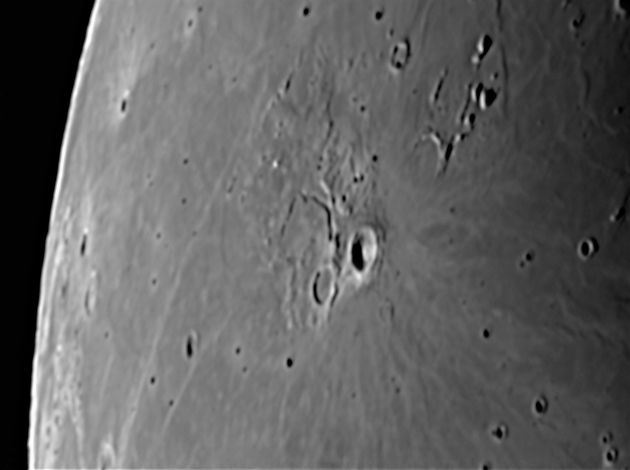
This is the same general area photographed on day 25.0 using my LX200 and Toucam 740 at prime focus. As such it is very like the picture two above.
The mouseover is an exaggerated-colour version of the same picture. Any difference in colour of this compared with the one above is of no significance and is caused by slightly different settings in the camera at capture. However the detail within the colour is significantly different.
The picture was taken with a ToUcam attached to my LX200 on 17th October 2006 at 04:10 UT when the Moon was 25.0 days old.
Libration: latitude -2° 32', longitude 5° 3'
Lunar Phase: 234.8°
Colongitude: 210.8°
Date and Time: 17th October 2006 04:10 UT
Camera: ToUcam 740K
Telescope: LX200 at prime focus (FL 2500 mm)
Capture: K3CCDTools. 50% gamma, 1/33", 31% gain, 644 frames
Processing: Registax. 5 alignment points, 582 frames stacked. Gaussian wavelets 2-3 (0.14) = 10, 1 (0.2)=0, gamma 1.3
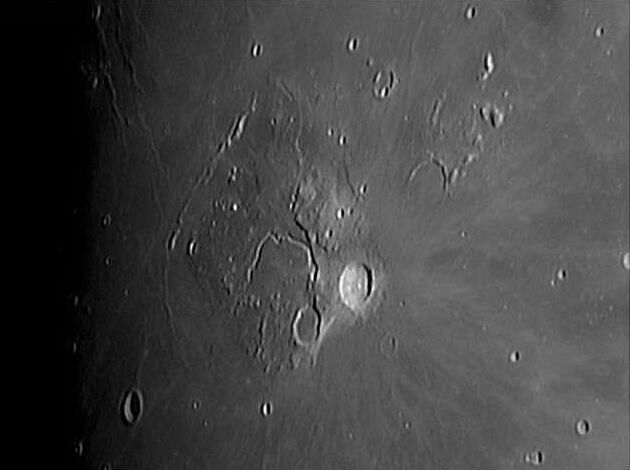
When I took this picture, the libration was favourable for this part of the Moon, tipping the Moon in
such a way as to give us a slightly less oblique view. Vaisala is the new name for Aristarchus A and is named after
Yrjo Väisälä, a Finnish astronomer and physicist who developed methods of testing optical elements and
enabled high-quality Schmidt telescopes to be built. This picture was made using a Schmidt telescope.
The scale markers are approximately 50 Km north and east.
The picture was taken with a ToUcam attached to my LX200 on 21st April 2005 at 20:15 UT when the Moon was 12.2 days old.
Libration: latitude -2° 1', longitude -4° 32'
Lunar Phase: 31.4°
Colongitude: 63.7°
Date and Time: 21st April 2005 20:15 UT
Camera: ToUcam 740K
Telescope: LX200 at prime focus (FL 2500 mm)
Capture: K3CCDTools. High gamma, 1/100", 0% gain, 326 frames
Processing: Registax. 138 frames stacked. Wavelets 1-3 = 10
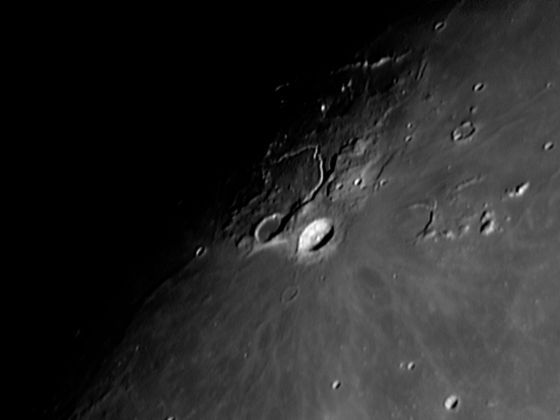
This picture of Schröter's Valley, taken in October 2004, was when
the age of the Moon is just the same as it was in the picture above, but the terminator is
much closer to the Valley in this picture. The reason is that libration has rotated the Moon over 9° to the left in this picture compared to the one above.
The scale markers are approximately 100 Km north and east.
The picture was taken with a ToUcam attached to my LX200 on 25th October 2004 at 22:19 UT when the Moon was 12.6 days old.
Libration: latitude 3° 38', longitude 5° 4'
Lunar Phase: 26.4°
Colongitude: 58.3°
Date and Time: 25th October 2004 22:19 UT
Camera: ToUcam 740K
Telescope: LX200 at prime focus (FL 2500 mm)
Capture: K3CCDTools. High gamma, 1/500", 0% gain, 453 frames
Processing: Registax. 108 frames stacked. Wavelets 1 = 10, 2 = 5
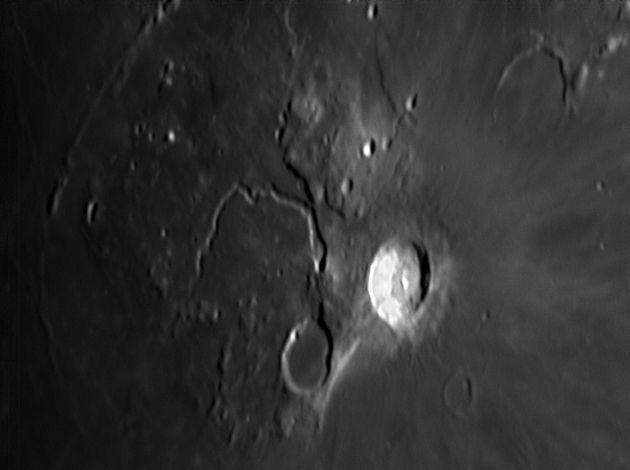
Here is a closer view of the same area. You can see just how bright Aristarchus is. This is because it is such a young
crater (only 450 million years old); the impact that created it cut through the dark lavas and exposed
the much lighter underlying rocks. It will take many more millions of years before micro-meteors
impacting this new rock tone it down to a more typical grey. (In this picture I have given crater Vaisala
its older name, Aristarchus A.)
The scale markers are approximately 50 Km north and east.
The picture was taken with a ToUcam attached to my LX200 with a X2 teleadaptor lens on 21st April 2005 at 21:55 UT when the Moon was 12.2 days old.
Libration: latitude -2° 1', longitude -4° 32'
Lunar Phase: 31.4°
Colongitude: 63.7°
Date and Time: 21st April 2005 21:55 UT
Camera: ToUcam 740K
Telescope: LX200 with X2 lens (FL 5000 mm)
Capture: K3CCDTools. Low gamma, 1/100", 39% gain, 326 frames
Processing: Registax. 222 frames stacked. Wavelets 1-3 = 10
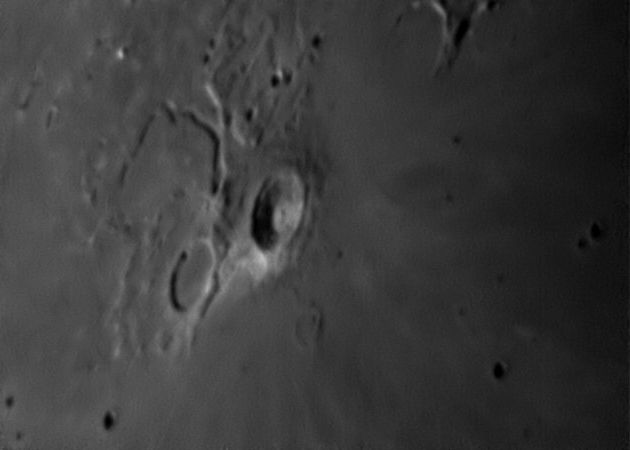
And now another close-up of the area, this time with the light coming from the other direction.
This picture was taken on 28th September 2005, when the Moon was 24.7 days old.
Libration: latitude -5° 51', longitude 2° 51'
Lunar Phase: 238.7°
Colongitude: 209.1°
Date and Time: 28th September 2005 03:09 UT
Camera: ToUcam 740K
Telescope: LX200 with X2 lens and IR-pass filter
Capture: K3CCDTools. Low gamma, 1/25", 73% gain, 412 frames
Processing: Registax. 225 frames stacked. Wavelet 2-3 = 10
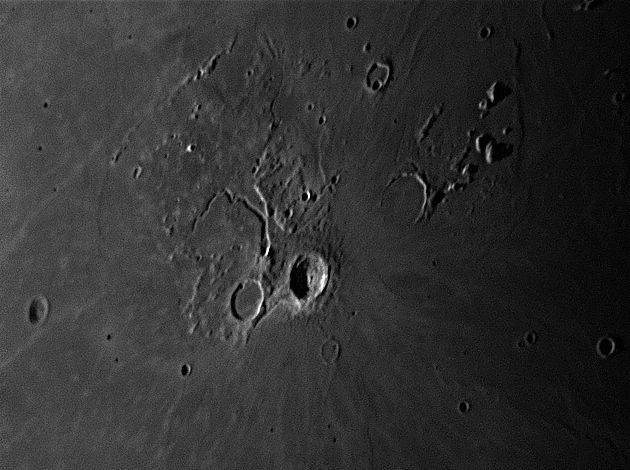
This picture is similar to the one taken on 21st April 2005 but the libration is even more favourable and the light is coming from the other direction. This gives us a good view of Aristarchus, Schröter's Valley, and the strangely rectangular Aristarchus Plateau.
The scale markers are approximately 50 Km west and north.
The picture was taken on 22nd October 2011, when the Moon was 24.3 days old.
Libration: latitude 6° 47', longitude -6° 17'
Lunar Phase: 244°
Colongitude: 212.8°
Date and Time: 22nd October 2011 05:21 UT
Camera: DMK 21AF04
Telescope: LX200 with CLS filter
Capture: ICCapture. 1/736", gain 1023, 3381 frames
Processing: Registax6. 5 alignment points, 100 frames stacked per alignment point, Gaussian wavelets Scheme 1
Focus Magic 1,100
Home Back to NW Quadrant